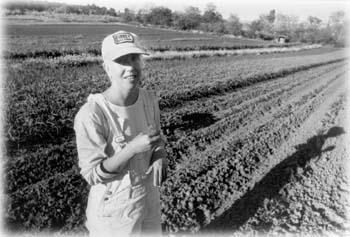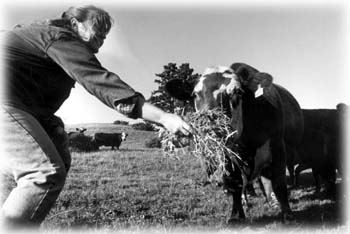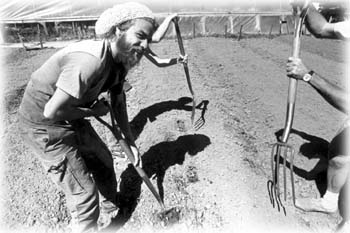![[MetroActive Dining]](/dining/gifs/dining468.gif)
![[MetroActive Dining]](/dining/gifs/dining468.gif)
[ Dining Index | Metro Santa Cruz | MetroActive Central | Archives ]
Earthly Pleasures
Outstanding in Her Field: UCSC Farm and Garden CSA coordinator Kathi Colen sizes up an about-to-be-planted-field near the campus facilities.
Community Supported Agriculture mixes green politics and fresh, flavorful harvests in its battle against giant agribusiness
By Christina Waters
THE SUBTLETIES OF SEASONAL change are so easy to miss here in California, where six months of summer dryness seem to switch over to six months of rain without much in the way of climactic foreplay. The earth's annual cycles are even easier to miss in the '90s, where (in the First World, at least) pavement has replaced meadows and chain supermarkets proudly proclaim that everything is "in season" at all time--sort of like the old tippler's joke that it's always cocktail time somewhere in the world.
Standing in the very center of the UCSC Farm, whose orchards and fields incline ever so slightly toward the ocean at its feet and curve upward toward the redwoods at its back, it's actually possible to feel deeply locked in the earth's embrace. It's like stepping into a Breughel landscape, where the ancient cycles of planting, harvesting, bending, sowing and reaping form the sole, joyful context for daily life.
I walk this land quite often, in all seasons. Its beauty takes my breath away as spring gathers its seductive strength and the soil warms up. Blossoms free-fall from apple trees, rows of herbs perfume the weathered old buildings and for the 2,000th day in a row, farm manager Jim Leap is out on his tractor finessing some new miracle of this incomparable five acres.
Last year, the farm belonged to me in a new sense. I joined its Community Supported Agriculture program, buying a share of the summer harvest that would enable Leap and his workers to purchase equipment and seed in advance, and that would allow me to pick up freshly picked produce, herbs and flowers every week from May until the end of November.
It was the deal of the century. Each week my sweetie and I would go through the huge box I lugged home--so heavy by melon time that I could barely carry it to the car--oohing and aahing over what "our farmers" had produced.
Strawberries still warm from the sun, curious little peppers, delicately colored potatoes, huge bouquets of basil with psychedelic aromas, amazing green beans, tart apples, lettuces and salad mixes of unearthly tenderness and flavor. There were golden beets and purple beets, pink beets and striped beets. Beets were big last year. But so were the famous dry-farmed tomatoes and round Japanese squashes that made killer pumpkin pies.
Each week there was something new, and as the summer deepened we could follow the cycles of the crops by what appeared and disappeared from each week's harvest. With each new meal we created--and believe me, vegetables became the staple of our summer menus, so glorious were the flavors--we literally tasted the garden, the changes of weather, temperature, length of daylight. By picking up the crops on the land, we got a chance to wander around the grounds and plots a bit, soak up the country atmosphere, pick a few herbs and cut a few more flowers, feeling as connected to it all as we'd been promised.
What's so unique about Community Sustainable Agriculture?
Where to find local CSAs.
Blows Against the Evil Empire of Agribusiness
ENJOYING NEW CACHET thanks to the huge popularity of the farmers' market phenomenon, Community Supported Agriculture appeals to consumers unwilling to exchange flavor and support of small local businesses for the convenience of year-round availability supplied by the Evil Empire of Agribusiness. The idea of CSAs came to this country in the mid-'80s from Japan and Europe, where the idea of Food Guilds--the holistic principles of biodynamic guru Rudolph Steiner--were already in full flower.
In essence, CSAs are contractual alliances between growers and consumers. At the beginning of a season--usually in May--local community members pay for weekly installments of freshly harvested produce. Their advance payment allows growers to purchase supplies, equipment and seed.
The grower, in turn, offers weekly "shares"--usually boxes filled with an allotment of produce enough to fulfill a small family's needs for a week--throughout the season. Prices range from $400 to $550 for a 24- to 28-week season, costing out at around $14 to $20 a week.
The benefits to both parties are obvious. Knowing just how much money they have to work with, farmers can plan their budgets in advance. Shareholders are guaranteed fresh, hand-grown, hand-harvested organic produce, as well as an invitation to be part of the farm's outdoor, non-urban atmosphere.
The Central Coast boasts a pioneering crop of CSAs, thanks to climate, politics and a network stimulated by the UCSC Center for Agroecology. Small farmers opening up their harvests to members of the community are busy sowing the seeds of change that many in the sustainable movement have long awaited.
North Coast Harvest
'FARMERS ARE gamblers," believes Brandon Ross of Swanton Pacific Ranch. "You can't strike it rich with a CSA--you can make a lot more by monocropping." Essentially, says Ross, CSA farmers present their costs to shareholders at the start of the season, "and that's the most you'll make that season."
The up side of the process is the close-knit sense of community between CSA land, growers and shareholders. "You're not just selling people something--it's an opportunity for people to come be on the farm. This place is incredible," he says, preaching to the choir.
Thanks to an endowment by legendary Swanton entrepreneur Al Smith (Orchard Supply Hardware was the family business), Ross and his colleague, LaDonna Seeley, direct a satellite agricultural ranch project for Cal PolySan Luis Obispo on acreage near Davenport. "It's a hands-on, working ranch that's currently in transition and will become certified organic next month," explains Seeley, who is from San Luis Obispo.
Ross, a graduate of UCSC's agroecology program and co-founder of the CSA West training program, did his thesis on the CSA phenomenon. "I'm sold on the concept," Ross admits. "Especially after the rush and craziness of working in the retail strawberry business--it just was not community-oriented enough."
This year the Swanton Pacific Ranch is offering CSA shares to a target population in Swanton, Bonny Doon and Davenport. "Everything is grown organically, and we've allocated six acres for the CSA worked by me full-time," Seeley notes, "and five or six interns during the summer." In addition to all the vegetable basics--including organic artichokes--the Swanton Ranch offers its shareholders samplings from a perennial herb garden and the run of a pumpkin patch.
What's unique about this CSA--in addition to its "add-on" shares for flowers, fresh eggs and firewood--is that "we offer natural, grass-fed beef," Seeley says with pride. "All our cattle were born and raised right here on the ranch." This is arguably the first time in generations that locally grown, naturally raised beef has been commercially available in the Santa Cruz area.
Moo-tiful Dreamer: LaDonna Seeley, Swanton Pacific Ranch's supervisor, feeds one of the Cal PolySan Luis Obispo satellite farm's cattle.
Joy to the World
NOT TOO FAR from Swanton as the crow flies, Boulder Creek's Camp Joy is continuing a seven-year tradition of offering shares in its showpiece organic garden. Of all the verdant gardens that encircle Santa Cruz county, Camp Joy is top contender for "Garden of Eden" designation. On five acres wedged between towering redwoods and the meandering San Lorenzo River, Jim Nelson (who first got his hands dirty as a student of Alan Chadwick in the late '60s) and his interns nurture and harvest enough vegetables, flowers, herbs and fruit to provide 30 shares to neighbors in the San Lorenzo Valley and Santa Cruz.
Though also busy with beekeeping and selling organic produce to New Leaf stores, Nelson admits that "the seasonal CSA is the main focus of my year." CSA shareholders can join in wide varieties of special events, from candle making to bread baking, all of which take place on this incomparable property, all of which create ties that bind the contractual community. Camp Joy growers encourage shareholders to come out and visit the garden on Thursdays, see what's going on and even dig in on the cultivating and harvest.
Growing South County
GRACED WITH abundant acreage, Happy Boy Farm has grown and shrunk in size over its 10 years of organic farming. Today, Andrew Griffin and Greg Beccio are expanding their 65-acre operation beyond the farmers' market circuit by starting a CSA. Coordinating the new community-oriented program for Happy Boy, Wendy Banzhaf says the move will be good for the farm economically, plus it provides "a wonderful community service. We're interested in connecting people with the people who grow their food."
Banzhaf says Happy Boy--famed for its impeccable salad mix so prized by Greater Bay Area restaurateurs--plans to provide three pickup sites for shareholders. "Our farm is very much out of the way," the CSA coordinator laughed, "so we plan to bring each week's shares to conveniently located parking lots in Monterey, Aptos and Santa Cruz. We're still scouting sites, and definitely want to hear from shareholders as to their needs."
Since Happy Boy has been on the Central Coast farmers' market circuit for years, the farm is set up for swift delivery. "We'd like to have 100 shareholders this year," Banzhof says, "and what we can offer is a wide variety of organic vegetables--tomatoes, corn, carrots, peppers, lettuce, garlic--everything. While we won't have a lot of fruit, there will be fresh herbs, flowers and a newsletter each week with recipes."
Banzhof promises at least one farm tour of the expansive acreage during the year, and Happy Boy is making a special point to reach out to enlightened restaurants and chefs by making restaurant shares available.
Pick and Choose: Derrick Adams and other members of Westside Santa Cruz's Homeless Garden work one of the project's vegetable plots.
Live Earth Farm
TOM AND CONSTANCE Broz walked away from the urban hustle of downtown San Francisco three years ago. "We found this beautiful piece of land in Watsonville," Broz recalls, "and moved here when our child was born." Inspired by 20 prime acres and an apprenticeship at the UCSC Farm & Garden, Live Earth Farm was born and is now open for its second CSA season.
"We do the farmers' markets and sell flowers at a lot of the area's natural foods stores," Broz said, "But eventually we want to focus just on CSA." For this farmer, the sense of community gained is the whole point of CSA. "We get to know who we're growing the food for--we can be in touch with our community members."
Agriculturally, doing a CSA forces Broz to focus on diversity. "We harvest lots of different crops all the time," he says. "And we customize the boxes of food each week." Almost like having a one-on-one relationship with crops and consumers.
"Last year, we had 25 members," says full-time Live Earth employee Leila Aldred. "This year, we hope to have 75 members. And we still have shares available."
Live Earth specializes in vegetables, augmented liberally with seasonal fruit like strawberries and melons. Life Earth has weekly CSA drop-off points in Scotts Valley, East Santa Cruz, Westside Santa Cruz and Aptos.
SC Crop Circles
ANY WAY YOU SLICE IT, the Homeless Garden Project--with combined area of just over three acres--is undeniably small. Started in 1990 as a nonprofit community organization, the Homeless Garden has provided satisfying and professionally rewarding work for apprentices, volunteers and trained farmers--homeless and otherwise.
Small it may be, but not only is this enterprise beloved of many eco-activists in Santa Cruz, it also supports a mighty CSA of 100 shareholders on beautifully tended gardens with an ocean view. The Homeless Garden's flower bouquets and wreaths have become famous with connoisseurs of fresh-picked, old-fashioned arrangements. But it's the incredible carrots and tender lettuces (and onions, and potatoes, and arugula, and bok choy) that linger long in the memory.
CSA coordinator Kevin Dolan says that this year members can come to the Pelton Street site for pick-ups on Tuesdays or Fridays--allowing them a chance to just wander for awhile around in all those fabulous flower beds and lushly composted soil. "And we'll also have some deliveries for people who need to make special arrangements," Dolan adds. Members in the Homeless Garden CSA tend to be Westside residents, "but they come all the way from Aptos to Scotts Valley, too."
Dolan says that anyone interested in joining the CSA is invited to come and visit the property at Pelton Street, across the street from Lighthouse Field. "We've just had a big planting party at the garden," he says. "It's really an amazing time to come walk the garden--we've just started the season."
There will be flower bouquets and herbs included in each week's CSA share, Dolan promises, "and people can come to cut their own vegetables if they like." Destined for its final season at the Pelton Street location, the Homeless Garden Project is already gearing up to plant itself firmly in new soil next year. "We have definite possibilities in the works," Dolan says.
Leap Years
A SENSUOUS PATCHWORK of interlocking gardens and orchards, the UCSC Farm supports a CSA of 60 shareholders on 4 1/2 organically cultivated acres. The final moments of winter find Jim Leap engaged in the on-going battle against oxalis--"a very pervasive early spring weed."
Leap is a lifelong agriculturist who left his farm in Fresno to take the job of farm manager eight years ago. His eyes, as if from years in the out-of-doors, have taken on the exact hue of the sky at twilight. "We've got plants started already in greenhouses," he explains. "May 1 is the real start date of our CSA, and our biggest push is to have a full box on the very first day."
Leap says that doing direct marketing through a CSA is a better bet economically than trying to wholesale, but it's also a much more intensive effort. "There are many more crops planted all at once, lots of diversity. I love it, actually, and we're a perfect set-up for that kind of farming."
Apprentices at the Farm & Garden spend some time of their tenure with Leap working on the ins and outs of CSA management. "With our seasonal CSA, the apprentices get to see how to do it for real," he says.
Leap admits that he's "pretty passionate about farming as a living. And CSAs are a beautiful model. They teach the consumer how to purchase food responsibly and seasonally." Leap says that the CSA at the Farm & Garden has come a long way from its first season, where "we had to figure out how to harvest, bunch, clean and merchandise over 40 different crops."
This year Kathi Colen acts as CSA coordinator, helping Leap integrate all these many elements.
"From my perspective," says Leap, "the CSA is a great way to do farming. There's cash up front, there's a link to the customer, and they get to know more about their food. The biggest benefit," he slows down for emphasis, "is the direct link. You get the sense of appreciation for all your work that you don't get anywhere else." Leap's shareholders can accept holes in the beets and crooked carrots. They know that the flavor is what's important. "I want the CSA members to know that this is their farm."
This page was designed and created by the Boulevards team.

Robert Scheer![[line]](/gifs/line.gif)
![[line]](/gifs/line.gif)

Robert Scheer
Robert Scheer
From the April 10-16, 1997 issue of Metro Santa Cruz
Copyright © 1997 Metro Publishing, Inc.